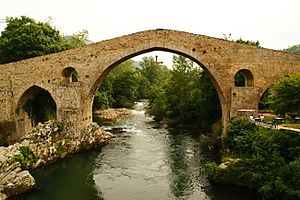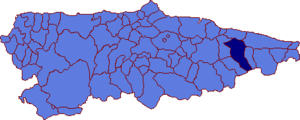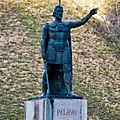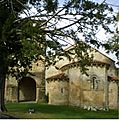Cangas de Onís facts for kids
Quick facts for kids
Cangas de Onís
Cangues d'Onís
|
||
|---|---|---|

The hump-backed "Roman Bridge" on the Sella River
|
||
|
||
 |
||
| Country | ||
| Autonomous community | ||
| Province | Asturias | |
| Comarca | Oriente | |
| Judicial district | Cangas de Onís | |
| Capital | Cangas de Onís | |
| Area | ||
| • Total | 212.75 km2 (82.14 sq mi) | |
| Highest elevation | 2,478 m (8,130 ft) | |
| Population
(2018)
|
||
| • Total | 6,278 | |
| • Density | 29.5088/km2 (76.427/sq mi) | |
| Demonym(s) | cangués | |
| Time zone | UTC+1 (CET) | |
| • Summer (DST) | UTC+2 (CEST) | |
| Postal code |
33547 to 33559
|
|
Cangas de Onís (in Asturian: Cangues d'Onís) is a town and a municipality in the eastern part of Asturias, a region in northwest Spain. The main town of the municipality is also called Cangas de Onís.
A big part of the municipality, over seventy square kilometers, is inside the amazing Picos de Europa National Park. This park is famous for its tall mountains and beautiful nature.
Contents
History of Cangas de Onís
The Start of a Kingdom
Cangas de Onís is a very important place in Spanish history. It was the first capital of the Kingdom of Asturias. This kingdom was one of the first Christian kingdoms in Spain after the Islamic conquest.
The Battle of Covadonga
Inside the national park, you'll find the village of Covadonga. This is where the battle of Covadonga happened around the year 722. This battle was a huge victory for Christian forces in Spain. It marked the beginning of the Reconquista, which was a long period when Christian kingdoms slowly took back control of Spain.
Ancient Churches and Bridges
The first church built in Spain after the conquest was Santa Cruz de Cangas de Onís. It was built in 737 on top of an ancient dolmen, which is a very old stone monument. The famous stone bridge over the Sella River, often called the "Roman Bridge" (even though it's from the 14th or 15th century), is also a key landmark.
Growth and Modern Times
Cangas de Onís grew quite a lot in the mid-19th century. Later, during the Spanish Civil War, the town was bombed several times. From 1978 to 1981, Cangas de Onís was the main seat for the regional government before Asturias became an official autonomous community in 1982.
Nature and Plants
Cangas de Onís has many different types of plants because its height changes a lot. You can find mountain shrubs like heather, as well as oak, hazel, and ash trees. There are also many green grasslands and small forests.
What People Do for Work
The main ways people earn a living in Cangas de Onís are through farming and raising animals. Tourism is also very important, especially for people who enjoy nature and the countryside. The nearby Covadonga Sanctuary and its beautiful lakes are one of the most popular places for tourists to visit in Asturias.
Areas of Cangas de Onís
The municipality of Cangas de Onís is divided into eleven smaller areas called parishes. These include:
- Abamia
- Cangas de Onís
- Con
- Covadonga
- Grazanes
- Labra
- Margolles
- La Riera
- Triongo
- Villanueva
- Zardón
The main town and capital of the municipality is the parish also named Cangas de Onís.
Famous People from Cangas de Onís
- Berta Piñán (born 1963), a writer and politician.
- Benjamina Miyar (1888–1961), a Spanish photographer, watchmaker, and a member of the anti-fascist resistance.
Gallery
-
Statue of the King Pelayo
-
Church of Santa Cruz - Lateral side
See also
 In Spanish: Cangas de Onís para niños
In Spanish: Cangas de Onís para niños












